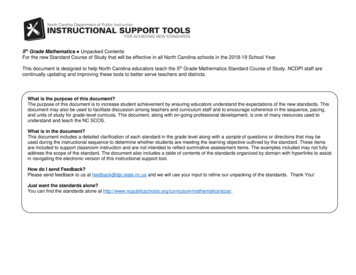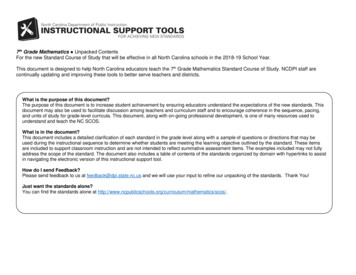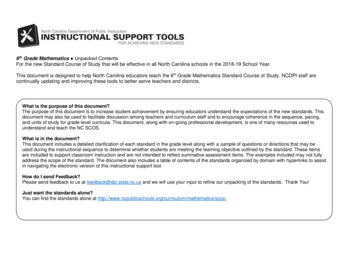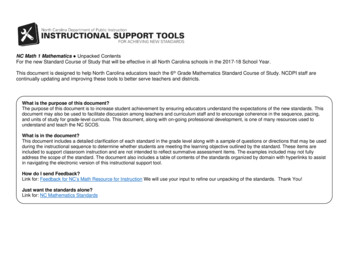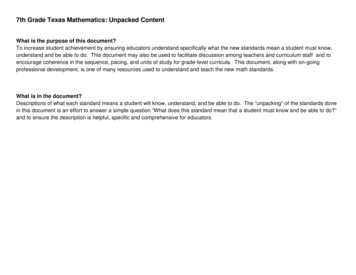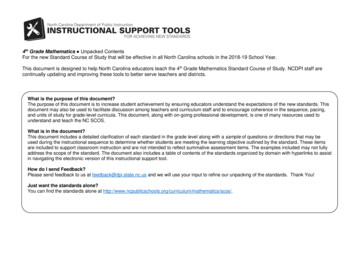
Transcription
4th Grade Mathematics Unpacked ContentsFor the new Standard Course of Study that will be effective in all North Carolina schools in the 2018-19 School Year.This document is designed to help North Carolina educators teach the 4th Grade Mathematics Standard Course of Study. NCDPI staff arecontinually updating and improving these tools to better serve teachers and districts.What is the purpose of this document?The purpose of this document is to increase student achievement by ensuring educators understand the expectations of the new standards. Thisdocument may also be used to facilitate discussion among teachers and curriculum staff and to encourage coherence in the sequence, pacing,and units of study for grade-level curricula. This document, along with on-going professional development, is one of many resources used tounderstand and teach the NC SCOS.What is in the document?This document includes a detailed clarification of each standard in the grade level along with a sample of questions or directions that may beused during the instructional sequence to determine whether students are meeting the learning objective outlined by the standard. These itemsare included to support classroom instruction and are not intended to reflect summative assessment items. The examples included may not fullyaddress the scope of the standard. The document also includes a table of contents of the standards organized by domain with hyperlinks to assistin navigating the electronic version of this instructional support tool.How do I send Feedback?Please send feedback to us at feedback@dpi.state.nc.us and we will use your input to refine our unpacking of the standards. Thank You!Just want the standards alone?You can find the standards alone at ics/scos/.
North Carolina Course of Study – 4th Grade StandardsStandards for Mathematical PracticeOperations & AlgebraicThinkingRepresent and solveproblems involvingmultiplication and division.NC.4.OA.1Use the four operations withwhole numbers to solveproblems.NC.4.OA.3Gain familiarity with factorsand multiples.NC.4.OA.4Generate and analyzepatterns.NC.4.OA.5Number & Operations inBase TenGeneralize place valueunderstanding for multi-digitwhole numbers.NC.4.NBT.1NC.4.NBT.2NC.4.NBT.7Use place valueunderstanding andproperties of operations toperform .6North Carolina Department of Public InstructionNumber & OperationsFractionExtend understanding offractions.NC.4.NF.1NC.4.NF.2Build fractions from unitfractions by applying andextending previousunderstandings ofoperations on wholenumbers.NC.4.NF.3Use unit fractions tounderstand operations offractions.NC.4.NF.4Understand decimal notationfor fractions, and comparedecimal fractions.NC.4.NF.6NC.4.NF.72Measurement & DataSolve problems lve problems involvingarea and perimeter.NC.4.MD.3Represent and interpretdata.NC.4.MD.4Understand concepts ofangle and measure angles.NC.4.MD.6GeometryClassify shapes based onlines and angles in twodimensional figures.NC.4.G.1NC.4.G.2NC.4.G.34th Grade Unpacking Document Rev. June 2018
Standards for Mathematical PracticePractice1. Make sense of problemsand persevere in solvingthem.2. Reason abstractly andquantitatively.3. Construct viablearguments and critiquethe reasoning of others.4. Model with mathematics.5. Use appropriate toolsstrategically.6. Attend to precision.7. Look for and make use ofstructure.8. Look for and expressregularity in repeatedreasoning.Explanation and ExampleMathematically proficient students in grade 4 know that doing mathematics involves solving problems and discussing how theysolved them. Students explain to themselves the meaning of a problem and look for ways to solve it. Fourth graders may useconcrete objects or pictures to help them conceptualize and solve problems. They may check their thinking by askingthemselves, “Does this make sense?” They listen to the strategies of others and will try different approaches. They often willuse another method to check their answers.Mathematically proficient fourth grade students should recognize that a number represents a specific quantity. They connectthe quantity to written symbols and create a logical representation of the problem at hand, considering both the appropriateunits involved and the meaning of quantities. They extend this understanding from whole numbers to their work with fractionsand decimals. Students write simple expressions, record calculations with numbers, and represent or round numbers usingplace value concepts.In fourth grade mathematically proficient students may construct arguments using concrete referents, such as objects, pictures,and drawings. They explain their thinking and make connections between models and equations. They refine theirmathematical communication skills as they participate in mathematical discussions involving questions like “How did you getthat?” and “Why is that true?” They explain their thinking to others and respond to others’ thinking.Mathematically proficient fourth grade students experiment with representing problem situations in multiple ways includingnumbers, words (mathematical language), drawing pictures, using objects, making a chart, list, or graph, creating equations,etc. Students need opportunities to connect the different representations and explain the connections. They should be able touse all of these representations as needed. Fourth graders should evaluate their results in the context of the situation andreflect on whether the results make sense.Mathematically proficient fourth grader students consider the available tools (including estimation) when solving a mathematicalproblem and decide when certain tools might be helpful. For instance, they may use graph paper or a number line to representand compare decimals and protractors to measure angles. They use other measurement tools to understand the relative size ofunits within a system and express measurements given in larger units in terms of smaller units.As fourth grader students develop their mathematical communication skills, they try to use clear and precise language in theirdiscussions with others and in their own reasoning. They are careful about specifying units of measure and state the meaningof the symbols they choose. For instance, they use appropriate labels when creating a line plot.In fourth grade mathematically proficient students look closely to discover a pattern or structure. For instance, students useproperties of operations to explain calculations (partial products model). They relate representations of counting problems suchas tree diagrams and arrays to the multiplication principal of counting. They generate number or shape patterns that follow agiven rule.Students in fourth grade should notice repetitive actions in computation to make generalizations Students use models toexplain calculations and understand how algorithms work. They also use models to examine patterns and generate their ownalgorithms. For example, students use visual fraction models to write equivalent fractions.Return to StandardsNorth Carolina Department of Public Instruction34th Grade Unpacking Document Rev. June 2018
Operations and Algebraic ThinkingRepresent and solve problems involving multiplication and division.NC.4.OA.1 Interpret a multiplication equation as a comparison. Multiply or divide to solve word problems involving multiplicative comparisons using models andequations with a symbol for the unknown number. Distinguish multiplicative comparison from additive comparison.ClarificationChecking for UnderstandingA multiplicative comparison is a situation in which one quantity is multiplied by Sally is five years old. Her mom is eight times older. How old is Sally’s Mom?a specified number to get another quantity (e.g., “a is n times as much as b”).In a multiplicative comparison, the underlying question is what factor wouldPossible response:multiply one quantity in order to result in the other. Students should be able to5 x 8 40.identify and verbalize which quantity is being multiplied and which numbertells how many times.40Students should be able to translate comparative situations into equationswith an unknown and solve. Many opportunities to solve contextual problemsand write and identify equations and statements for multiplicative comparisonshould be provided.55555555A book costs 18. That is 3 times more than a DVD. How much does a DVDcost?Possible response:18 p 3or 3 x p 18Return to StandardsNorth Carolina Department of Public Instruction44th Grade Unpacking Document Rev. June 2018
Use the four operations with whole numbers to solve problems.NC.4.OA.3 Solve two-step word problems involving the four operations with whole numbers. Use estimation strategies to assess reasonableness of answers. Interpret remainders in word problems. Represent problems using equations with a letter standing for the unknown quantity.ClarificationChecking for UnderstandingThe focus in this standard is to have students use and discuss variousOn a vacation, your family travels 267 miles on the first day, 194 miles on thestrategies for solving word problems using all four operations. Studentssecond day and 34 miles on the third day. How many miles did they travelshould build on the problem solving strategies they developed in earliertotal? How do you know your answer is reasonable?grades and apply those strategies to multi-step problems.Possible responses:Students should be introduced to a variety of estimation strategies.Student 1Student 2Student 3Estimation strategies include identifying when estimation is appropriate,I first thought about 267 I first thought aboutI rounded 267 to 300. Idetermining the level of accuracy needed, selecting the appropriate methodand 34. I noticed that194. It is really close torounded 194 to 200. Iof estimation, and verifying solutions or determining the reasonableness oftheir sum is about 300.200. I also have 2rounded 34 to 30.situations using various estimation strategies. Estimation strategies include,Then I knew that 194 is hundreds in 267. ThatWhen I added 300, 200but are not limited to:close to 200. When Igives me a total of 4and 30, I know myput 300 and 200hundreds. Then I haveanswer will be about front-end estimation with adjusting (using the highest place value andtogether, I get 500.67 in 267 and the 34.530.estimating from the front end, making adjustments to the estimate byWhen I put 67 and 34taking into account the remaining amounts),together that is really clustering around an average (when the values are close together anclose to 100. When Iaverage value is selected and multiplied by the number of values toadd that hundred to thedetermine an estimate),4 hundreds that I rounding and adjusting (students round down or round up and thenalready had, I end upadjust their estimate depending on how much the rounding affectedwith 500.the original values), using friendly or compatible numbers such as factors (students seekto fit numbers together - e.g., rounding to factors and groupingYour class is collecting bottled water for a service project. The goal is to collectnumbers together that have round sums like 100 or 1000),300 bottles of water. On the first day, Max brings in 6 packs with 6 bottles ineach container. About how many bottles of water still need to be collected? using benchmark numbers that are easy to compute (students selectclose whole numbers for fractions or decimals to determine anPossible responses:estimate).Problems should be structured so that all acceptable estimation strategies willarrive at a reasonable answer. The assessment of estimation strategiesshould only have one reasonable answer (500 or 530), or a range (between500 and 550).Student 1First, I multiplied 6 and 6 whichequals 36. I’m trying to get to 300. 36is close to 40, and 40 plus 60 is 100.Then I need 2 more hundreds. So,we still need about 260 bottles.This standard also references interpreting remainders. Remainders should beput into context for interpretation. Ways to address remainders: Remain as a left over Partitioned into fractions or decimals Discarded leaving only the whole number answer Increase the whole number answer up one Round to the nearest whole number for an approximate resultNorth Carolina Department of Public Instruction5Student 2First, I multiplied 6 and 6 whichequals 36. I know 36 is about 40 and300-40 260, so we need about 260more bottles.4th Grade Unpacking Document Rev. June 2018
Use the four operations with whole numbers to solve problems.NC.4.OA.3 Solve two-step word problems involving the four operations with whole numbers. Use estimation strategies to assess reasonableness of answers. Interpret remainders in word problems. Represent problems using equations with a letter standing for the unknown quantity.ClarificationChecking for UnderstandingWrite different word problems involving 44 6 ? where the answers are bestrepresented as:Problem A: 7Problem B: 7 r 2Problem C: 8Problem D: 7 or 8Problem E: 7 26Possible responses:Problem A: 7. Mary had 44 pencils. Six pencils fit into each of herpencil pouches. How many pouches did she fill? 44 6 p; p 7 r 2.Mary can fill 7 pouches completely.Problem B: 7 r 2. Mary had 44 pencils. Six pencils fit into each of herpencil pouches. How many pouches could she fill and how manypencils would she have left? 44 6 p; p 7 r 2; Mary can fill 7pouches and have 2 left over.Problem C: 8. Mary had 44 pencils. Six pencils fit into each of herpencil pouches. What would the fewest number of pouches she wouldneed in order to hold all of her pencils? 44 6 p; p 7 r 2; Maryneeds 8 pouches to hold all of the pencils.Problem D: 7 or 8. Mary had 44 pencils. She divided them equallyamong her friends before giving one of the leftovers to each of herfriends. How many pencils could her friends have received? 44 6 p;p 7 r 2; Some of her friends received 7 pencils. Two friends received8 pencils.Problem E: 7 2 . Mary had 44 pencils and put six pencils in each6pouch. What fraction represents the number of pouches that Maryfilled? 44 6 p; p 7 26There are 1,128 students going on a field trip. If each bus held 30 students,how many buses are needed?1,128 30 b; b 37 R 6; They will need 38 buses because 37 buseswould not hold all of the students.Return to StandardsNorth Carolina Department of Public Instruction64th Grade Unpacking Document Rev. June 2018
Gain familiarity with factors and multiples.NC.4.OA.4 Find all factor pairs for whole numbers up to and including 50 to: Recognize that a whole number is a multiple of each of its factors. Determine whether a given whole number is a multiple of a given one-digit number. Determine if the number is prime or composite.ClarificationChecking for UnderstandingThis standard requires students to demonstrate understanding of factors andThere are 24 chairs in the art room. What are the different ways that the chairsmultiples of whole numbers up to and including 50. Factor pairs include twocan be arranged into equal groups if you want at least 2 groups and want atnumbers that when multiplied result in a particular product. Students shouldleast 2 chairs in each group?be given opportunities to explore factor pairs with concrete objects and How do you know that you have found every arrangement? Writedrawings to represent arrays.division equations to show your answers.There are 48 chairs in the multi-purpose room. What are the different ways thatMultiples are the result of multiplying two whole numbers. Multiples can bethe chairs can be arranged into equal groups if you want at least 2 groups andrelated to factors, and this relationship can be discovered through exploration want at least 2 chairs in each group?with arrays. Students can build on their understanding of skip counting by a How do you know that you have found every arrangement? Writegiven number to determine the multiples of the given number.division equations to show your answers. What relationship do you notice about the size of the groups if theAs students explore and discover patterns, they build a conceptualchairs were arranged in 4 groups in both Part 1 and Part 2?understanding of prime and composite numbers. Prime numbers have exactly What about if the chairs were arranged in 8 groups? Explain why youtwo factors, the number one and their own number. For example, the numberthink this relationship exists.17 has the factors of 1 and 17. Composite numbers have more than twofactors. For example, 8 has the factors 1, 2, 4, and 8. A commonA landscaping company visits the school to talk about the possible ways to tile amisconception is that the number 1 is prime, when it is neither prime norpatio and picnic area near the playground. The school can afford between 24composite. Another common misconception is that all prime numbers are oddand 30 square tiles.numbers. This is not true, since the number 2 has only 2 factors, 1 and 2, and For each of the proposed number of tiles (24-30), determine all of theis also an even number.possible dimensions of rectangles you could make. The space for the patio is configured so that there cannot be any morethan 10 tiles in a row. For the proposed number of tiles (24-30),determine which numbers would work as the total number of tiles. Which number of tiles provides the most flexibility in terms of thepossible ways that the tiles could be arranged? Explain your reasoning.Return to StandardsNorth Carolina Department of Public Instruction74th Grade Unpacking Document Rev. June 2018
Generate and analyze patterns.NC.4.OA.5 Generate and analyze a number or shape pattern that follows a given rule.ClarificationChecking for UnderstandingThe ability to recognize and explain patterns in mathematics leads students to Ted and Nancy both mow lawns during the summer to earn money.developing the ability to make generalizations, a foundational concept inTed charges 10 per lawn and 2 per hour.algebraic thinking. Students need multiple opportunities creating andNancy charges 4 per lawn and 4 per hour.extending number and shape patterns. This standard does not requirestudents to infer or guess the underlying rule for a pattern, but rather asksComplete the table to show how much Ted and Nancy would each earn basedthem to generate a pattern from a given rule and identify features of the given on the amount of time that it took to mow a lawn.pattern.TedNancy½ hourPatterns and rules are related. A pattern is a sequence that repeats the same1 hourprocess over and over. A rule dictates what that process will look like.1 and ½ hoursStudents investigate different patterns to find rules, identify features in the2 hourspatterns, and justify the reason for those features.2 and ½ hours3 hoursThis standard begins with a small focus on reasoning about a number or3 and ½ hoursshape pattern, connecting a rule for a given pattern with its sequence of4 hoursnumbers or shapes. Patterns that consist of repeated sequences of shapes orgrowing sequences of designs would be appropriate for fourth grade.There are 4 beans in the jar. Each day 3 beans are added. How many beansare in the jar for each of the first 5 days?DayOperationBeans03x0 4413x1 4723x2 41033x3 41343x4 41653x5 419Return to StandardsNorth Carolina Department of Public Instruction84th Grade Unpacking Document Rev. June 2018
Number and Operations in Base TenGeneralize place value understanding for multi-digit whole numbers.NC.4.NBT.1 Explain that in a multi-digit whole number, a digit in one place represents 10 times as much as it represents in the place to its right, up to 100,000.ClarificationChecking for UnderstandingThis standard calls for students to extend their understanding of place valuePart 1:related to multiplying and dividing by multiples of 10. In this standard,Gina said, “In my pocket I have 25 of the same amount of dollar bills. What isstudents should reason about the magnitude of digits in a number. In thethe value of Gina’s money if she has:base-ten system, the value of each place is 10 times the value of the place toa) 25 one dollar billsthe immediate right. Students should reason and analyze the relationships ofb) 25 ten dollar billsnumbers that they are working with.c) 25 hundred dollar billsPart 2:Gina reasoned, “The value of the 2 when I have ten dollar bills is 200, but thevalue of the 2 when I have one dollar bills is only 20.” Is Gina correct? Why orwhy not?Part 3:If you had 260 of each of the kinds of dollar bills in parts a, b, and c above; whatwould the value of each kind of bill be? Explain how you found your answer.Generalize place value understanding for multi-digit whole numbers.NC.4.NBT.2 Read and write multi-digit whole numbers up to and including 100,000 using numerals, number names, and expanded form.ClarificationChecking for UnderstandingThis standard asks for students to write numbers in various forms. StudentsJuice pouches are packaged in different ways. A box holds 10 pouches. A caseshould have flexibility with the different forms of a number.holds 10 boxes. A crate holds 10 cases.Written form or number name is to write out a number in words like “twohundred eighty-five.” Traditional expanded form is 285 200 80 5.However, students should have opportunities to explore the idea that 285could also be 28 tens plus 5 ones or 1 hundred, 18 tens, and 5 ones. Theyshould also be comfortable with expanding a number by place value such as(2 x 100) (8 x 10) (5 x 1).To read numerals between 1,000 and 100,000, students need to understandthe role of commas. Each section between commas is read a hundreds, tens,and ones followed by the appropriate unit (thousands). 97,345 would be readninety-seven thousand, three hundred forty-five.Some students bring in juice boxes for Field Day. The information is below.Miguel- 1 crate, 12 cases, 3 boxes and 6 pouches.Aaron- 1 crate, 13 cases, 17 boxes, and 2 pouches.Sarah- 1 crate, 12 cases, 2 boxes and 17 pouches.Vicky- 1 crate, 14 cases, 6 boxes, and 9 pouches.1) If each person were going to reorganize their drink pouches to use as manyof the larger containers as possible, how many of each container wouldeach of them need?2) How many total drink pouches does each student have?Return to StandardsNorth Carolina Department of Public Instruction94th Grade Unpacking Document Rev. June 2018
Generalize place value understanding for multi-digit whole numbers.NC.4.NBT.7 Compare two multi-digit numbers up to and including 100,000 based on the values of the digits in each place, using , , and symbols to recordthe results of comparisons.ClarificationChecking for UnderstandingIn this standard, students use their understanding of groups and value ofCompare these two numbers. 75,452 75,455digits to compare two numbers by examining the value of the digits. Studentsare expected to be able to compare numbers presented in various forms.Possible responses:Student AStudent BStudents should have ample experiences communicating their comparisonsPlace ValueCountingin words before using symbols. Students were introduced to the symbolsgreater than ( ), less than ( ) and equal to ( ) in First Grade and continue to75,452 has 75 thousands, 475,452 is less than 75,455. I knowuse them.hundreds, 5 tens, and 2 ones. 75,455 this because they have the samehas 75 thousands, 4 hundreds, 5thousands. So, I’m going to compareWhile students may have the skills to order more than 2 numbers, thistens, and 5 ones. They have the452 and 455. When I count up I saystandard focuses on comparing two numbers and using reasoning aboutsame number of thousands,452 before I say 455. 75,452 is lessplace value to support the use of the various symbols.hundreds and the same number ofthan 75,455.tens, but 455 has 5 ones and 75,452only has 2 ones. 75,452 is less than75,452 75,455455.75,452 75,455Return to StandardsNorth Carolina Department of Public Instruction104th Grade Unpacking Document Rev. June 2018
Use place value understanding and properties of operations to perform multi-digit arithmetic.NC.4.NBT.4 Add and subtract multi-digit whole numbers up to and including 100,000 using the standard algorithm with place value understanding.ClarificationChecking for UnderstandingIn this standard, students build on their conceptual understanding of additionThe following amounts of juice were in separate containers after the school’sand subtraction, their use of place value and their flexibility with multipleparent breakfast.strategies to make sense of the standard algorithm. They continue to use Container 1: 750 mLplace value in describing and justifying the processes they use to add and Container 2: 1,450 mLsubtract. Students are expected to explain their thinking to show Container 3: 2,087 mLunderstanding of the algorithm. Container 4: 299 mL Container 5: 476 mLThis is the first grade level in which students are expected to be proficient atusing the standard algorithm to add and subtract. However, other previouslyIf all of the liquid was put into one large container how much liquid would be inlearned strategies are still appropriate for students to use.the large container?In mathematics, an algorithm is defined by its steps and not by the way thosesteps are recorded in writing. With this in mind, minor variations in methods ofrecording standard algorithms are acceptable.Students may ask if it is possible to subtract a larger number from a smallernumber. While it is not the focus or expectation of this standard in this grade,students should know that it is mathematically possible, and they will belearning more about that concept in later grades. If the misconception thatlarger numbers cannot be subtracted from smaller numbers is confirmed orreinforced, students may struggle to make the transition to negative numbersin later grades.On a field trip, three different schools send their fourth graders across town tothe high school for a math competition. Each school sends between 120 and170 students each. There are 417 students total.1. How many students could have come from each school? Show yourthinking.2. Find another possible solution to this task. Show your thinking.3. If the number of students from each school was the same, how manystudents came from each school? Explain how you found your solution.Return to StandardsNorth Carolina Department of Public Instruction114th Grade Unpacking Document Rev. June 2018
Use place value understanding and properties of operations to perform multi-digit arithmetic.NC.4.NBT.5 Multiply a whole number of up to three digits by a one-digit whole number, and multiply up to two two-digit numbers with place value understandingusing area models, partial products, and the properties of operations. Use models to make connections and develop the algorithm.ClarificationChecking for UnderstandingIn this standard, students extend their understanding of multiplying a singleThere are 25 dozen cookies in the bakery. What is the total number of cookiesdigit factor times a multiple of ten to multiplying a single-digit factor timesat the bakery?multi-digit factors. Students will also begin their exploration of multiplying twoPossible responses:two-digit factors. Students should be able to apply their understanding ofplace value and various forms of a number to compute products. Students willStudent AStudent BStudent Calso use area models, partial products and properties of operations to solve25 x1225 x 1225 x 12multiplication problemsI broke 12 up into 10 I broke 25 up into 5I doubled 25 and cut 122groups of 5in half to get 50 x 6Connections should be made between models and written equations, but it isnot necessary for fourth grade students to use the standard algorithm. The25 x 10 2505 x 12 6050 x 6 300standard algorithm for multiplication is not an expectation until fifth grade.25 x 2 50There are 5 groups of 5250 50 300in 2560 x 5 300In the cafeteria, there are 14 long tables. Each table seats 16 students. Howmany students can eat in the cafeteria at one time?Using base ten blocks to model this problem, thisstudent sees:(10 4) x (10 6) 1 hundred4 tens6 tens24 ones10 x 104 x 106 x 106x410040602414 x 16 224There are 38 buses in the parking lot, and each bus holds 74 people. Howmany people are able to ride the buses?This student draws an area model.The student uses the model andunderstanding of partial products tosolve the multiplication problem.Return to StandardsNorth Carolina Department of Public Instruction124th Grade Unpacking Document Rev. June 2018
Use place value understanding and properties of operations to perform multi-digit arithmetic.NC.4.NBT.6 Find whole-number quotients and remainders with up to three-digit dividends and one-digit divisors with place value understanding usingrectangular arrays, area models, repeated subtraction, partial quotients, properties of operations, and/or the relationship between multiplication and division.ClarificationChecking for UnderstandingIn this standard, students build on their understanding of the meaning ofA 4th grade teacher bought 4 new pencil boxes. She has 260 pencils. Shedivision and the relationship to multiplication by modeling, writing, andwants to put the pencils in the boxes so that each box has the same number ofexplaining division by a one-digit divisor. This standard calls for students topencils. How many pencils will there be in each box?explore division through various strategies. Students should be able to applytheir understanding of place value and various forms of a number to compute Possible responses:quotients. Students will also use arrays and area models, repeated Using Base 10 Blocks: Students build 260 with base 10 blocks andsubtraction, partial quotients and properties of operations to solve divisiondistribute them into 4 equal groups. Some students may need to tr
4th Grade Mathematics Unpacked Contents For the new Standard Course of Study that will be effective in all North Carolina schools in the 2018-19 School Year. This document is designed to help North Carolina educators teach the 4th Grade
